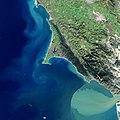| Tomales Bay | |
|---|---|
 Tomales Bay as viewed from Tomales Point Trail | |
| Coordinates | 38°08′55″N122°53′52″W / 38.14860°N 122.89787°W |
| Type | Bay |
| Ocean/sea sources | Pacific Ocean |
| Basin countries | United States |
| Max. length | 15 km (9.3 mi) |
| Max. width | 1.6 km (0.99 mi) |
| Settlements | Inverness Inverness Park Point Reyes Station Marshall |
| Official name | Tomales Bay |
| Designated | October 21, 2002 |
| Reference no. | 1215 [1] |
Tomales Bay is a long, narrow inlet of the Pacific Ocean in Marin County in northern California in the United States.









